Ruth Bader Ginsburg
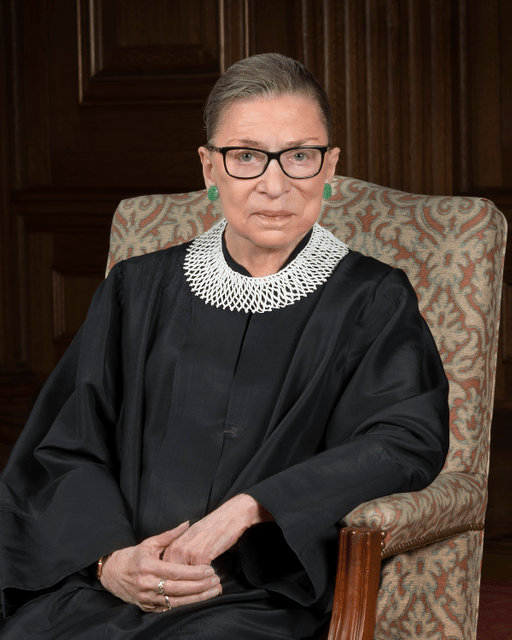
Ruth Bader Ginsburg

| Associate Justice of the Supreme Court of the United States | |
|---|---|
| August 10, 1993 | |
| Bill Clinton | |
| Byron White | |
| Judge of theUnited States Court of Appeals for the District of Columbia Circuit | |
| June 30, 1980 – August 9, 1993 | |
| Jimmy Carter | |
| Harold Leventhal | |
| David Tatel | |
| Personal details | |
| Born | |
| Spouse(s) | |
| Children | |
| Education | Cornell University(BA)Harvard University(attended)Columbia University(JD) |
| Signature | |
Ruth Bader Ginsburg (/ˈbeɪdər ˈɡɪnzbɜːrɡ/, born Joan Ruth Bader; March 15, 1933)[9] is an American lawyer and jurist who is an Associate Justice of the U.S. Supreme Court. Ginsburg was appointed by President Bill Clinton and took the oath of office on August 10, 1993. She is the second female justice (after Sandra Day O'Connor) of four to be confirmed to the court (along with Sonia Sotomayor and Elena Kagan, who are still serving). Following O'Connor's retirement, and until Sotomayor joined the court, Ginsburg was the only female justice on the Supreme Court. During that time, Ginsburg became more forceful with her dissents, which were noted by legal observers and in popular culture. She is generally viewed as belonging to the liberal wing of the court. Ginsburg has authored notable majority opinions, including United States v. Virginia, Olmstead v. L.C., and Friends of the Earth, Inc. v. Laidlaw Environmental Services, Inc.
Ginsburg was born in Brooklyn, New York. Her older sister died when she was a baby, and her mother, one of her biggest sources of encouragement, died shortly before Ginsburg graduated from high school. She then earned her Bachelor's degree at Cornell University, and became a wife and mother before starting law school at Harvard Law School, where she was one of the few women in her class. Ginsburg transferred to Columbia Law School, where she graduated tied for first in her class. Following law school, Ginsburg turned to academia. She was a Professor at Rutgers Law School and Columbia Law School, teaching civil procedure as one of the few women in her field.
Ginsburg spent a considerable part of her legal career as an Advocate for the advancement of gender equality and women's rights, winning multiple victories arguing before the Supreme court. She advocated as a volunteer lawyer for the American Civil Liberties Union and was a member of its board of directors and one of its general counsels in the 1970s. In 1980, President Jimmy Carter appointed her to the U.S. Court of Appeals for the District of Columbia Circuit, where she served until her appointment to the Supreme Court. Ginsburg has received attention in American popular culture for her fiery liberal dissents and refusal to step down; she has been dubbed "The Notorious R.B.G." in reference to the late rapper known as "The Notorious B.I.G.".[10]
| Associate Justice of the Supreme Court of the United States | |
|---|---|
| August 10, 1993 | |
| Bill Clinton | |
| Byron White | |
| Judge of theUnited States Court of Appeals for the District of Columbia Circuit | |
| June 30, 1980 – August 9, 1993 | |
| Jimmy Carter | |
| Harold Leventhal | |
| David Tatel | |
| Personal details | |
| Born | |
| Spouse(s) | |
| Children | |
| Education | Cornell University(BA)Harvard University(attended)Columbia University(JD) |
| Signature | |
Early life and education
Joan Ruth Bader was born on March 15, 1933, in the New York City borough of Brooklyn, the second daughter of Celia (née Amster) and Nathan Bader, who lived in the Flatbush neighborhood. Her father was a Jewish emigrant from Odessa, Ukraine, then in the Russian Empire, and her mother was born in New York to Austrian Jewish parents.[11][12][13] The Baders' older daughter Marylin died of meningitis at age six, when Ruth was 14 months old.[9] [14][15] The family called Joan Ruth "Kiki", a nickname Marylin had given her for being "a kicky baby".[9] [16] When "Kiki" started school, Celia discovered that her daughter's class had several other girls named Joan, so Celia suggested that the teacher call her daughter "Ruth" to avoid confusion.[9] Although not devout, the Bader family belonged to East Midwood Jewish Center, a Conservative synagogue, where Ruth learned tenets of the Jewish faith and gained familiarity with the Hebrew language.[9] At age 13, Ruth acted as the "camp rabbi" at a Jewish summer program at Camp Che-Na-Wah in Minerva, New York.[16]
Celia took an active role in her daughter's Education, often taking her to the library.[16] Celia had been a good student in her youth, graduating from high school at age 15, yet she could not further her own education because her family instead chose to send her brother to college. Celia wanted her daughter to get more education, which she thought would allow Ruth to become a high school history teacher.[17] Ruth attended James Madison High School, whose law program later dedicated a courtroom in her honor. Celia struggled with cancer throughout Ruth's high school years and died the day before Ruth's high school graduation.[16]
Bader attended Cornell University in Ithaca, New York, where she was a member of Alpha Epsilon Phi.[18] While at Cornell, she met Martin D. Ginsburg at age 17.[17] She graduated from Cornell with a Bachelor of Arts degree in Government on June 23, 1954. She was a member of Phi Beta Kappa and the highest-ranking female student in her graduating class.[18][19] Bader married Ginsburg a month after her graduation from Cornell. She and Martin moved to Fort Sill, Oklahoma, where he was stationed as a Reserve Officers' Training Corps officer in the Army Reserve after his call-up to active duty.[17][20][19] At age 21, she worked for the Social Security Administration office in Oklahoma, where she was demoted after becoming pregnant with her first child.[15] She gave birth to a daughter in 1955.[15]
In the fall of 1956, Ginsburg enrolled at Harvard Law School, where she was one of only nine women in a class of about 500 men.[21][22] The Dean of Harvard Law reportedly invited all of the female law students to dinner at his family home and asked the female law students, including Ginsburg, "Why are you at Harvard Law School, taking the place of a man?"[1][17][23][24] When her husband took a job in New York City, Ginsburg transferred to Columbia Law School and became the first woman to be on two major law reviews: the Harvard Law Review and Columbia Law Review. In 1959, she earned her law degree at Columbia and tied for first in her class.[16][25]
Early career
At the start of her legal career, Ginsburg encountered difficulty in finding employment.[26][27][28] In 1960, Supreme Court Justice Felix Frankfurter rejected Ginsburg for a clerkship position due to her gender. She was rejected despite a strong recommendation from Albert Martin Sacks, who was a professor and later dean of Harvard Law School.[26][30][2] Columbia Law Professor Gerald Gunther also pushed for Judge Edmund L. Palmieri of the U.S. District Court for the Southern District of New York to hire Ginsburg as a law clerk, threatening to never recommend another Columbia student to Palmieri if he did not give Ginsburg the opportunity and guaranteeing to provide the judge with a replacement clerk should Ginsburg not succeed.[15][16][31] Later that year, Ginsburg began her clerkship for Judge Palmieri, and she held the position for two years.[15][16]
Academia
From 1961 to 1963, Ginsburg was a research associate and then an associate director of the Columbia Law School Project on International Procedure; she learned Swedish to co-author a book with Anders Bruzelius on civil procedure in Sweden.[32][33] Ginsburg conducted extensive research for her book at Lund University in Sweden.[34] Ginsburg's time in Sweden also influenced her thinking on gender equality. She was inspired when she observed the changes in Sweden, where women were 20 to 25 percent of all law students; one of the judges whom Ginsburg watched for her research was eight months pregnant and still working.[17]
Her first position as a professor was at Rutgers Law School in 1963.[35] The appointment was not without its drawbacks; Ginsburg was informed she would be paid less than her male colleagues because she had a husband with a well-paid job.[28] At the time Ginsburg entered academia, she was one of fewer than 20 female law professors in the United States.[35] She was a professor of law, mainly civil procedure, at Rutgers from 1963 to 1972, receiving tenure from the school in 1969.[36][37]
In 1970, she co-founded the Women's Rights Law Reporter, the first law journal in the U.S. to focus exclusively on women's rights.[38] From 1972 to 1980, she taught at Columbia, where she became the first tenured woman and co-authored the first law school casebook on sex discrimination.[37] She also spent a year as a fellow of the Center for Advanced Study in the Behavioral Sciences at Stanford University from 1977 to 1978.[24]
Litigation and advocacy
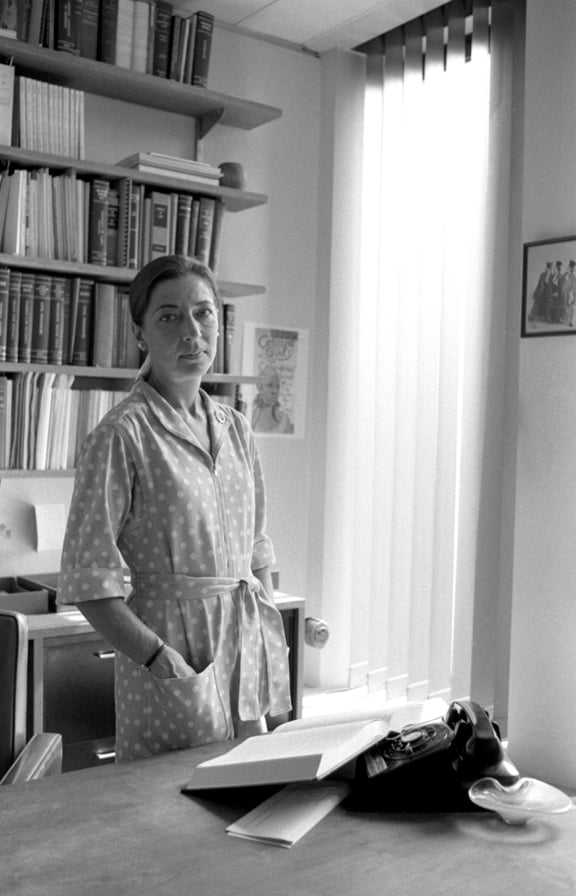
Ginsburg in 1977, photographed by Lynn Gilbert
In 1972, Ginsburg co-founded the Women's Rights Project at the American Civil Liberties Union (ACLU) and, in 1973, she became the Project's general counsel.[19] The Women's Rights Project and related ACLU projects participated in over 300 gender discrimination cases by 1974. As the director of the ACLU's Women's Rights Project, she argued six gender discrimination cases before the Supreme Court between 1973 and 1976, winning five.[26] Rather than asking the court to end all gender discrimination at once, Ginsburg charted a strategic course, taking aim at specific discriminatory statutes and building on each successive victory. She chose plaintiffs carefully, at times picking male plaintiffs to demonstrate that gender discrimination was harmful to both men and women.[37][26] The laws Ginsburg targeted included those that on the surface appeared beneficial to women, but in fact reinforced the notion that women needed to be dependent on men.[26] Her strategic advocacy extended to word choice, favoring the use of "gender" instead of "sex", after her secretary suggested the word "sex" would serve as a distraction to judges.[37] She attained a reputation as a skilled oral advocate and her work led directly to the end of gender discrimination in many areas of the law.[40]
Ginsburg volunteered to write the brief for Reed v. Reed, 404 U.S. 71 [219] (1971), in which the Supreme Court extended the protections of the Equal Protection Clause of the Fourteenth Amendment to women.[37][41][3] She argued and won Frontiero v. Richardson, 411 U.S. 677 [220] (1973), which challenged a statute making it more difficult for a female service member to claim an increased housing allowance for her husband than for a male service member seeking the same allowance for his wife. Ginsburg argued that the statute treated women as inferior, and the Supreme Court ruled 8–1 in her favor.[26] The court again ruled in Ginsburg's favor in Weinberger v. Wiesenfeld, 420 U.S. 636 (1975), where Ginsburg represented a widower denied survivor benefits under Social Security, which permitted widows but not widowers to collect special benefits while caring for minor children. She argued that the statute discriminated against male survivors of workers by denying them the same protection as their female counterparts.[43]
Ginsburg filed an amicus brief and sat with counsel at oral argument for Craig v. Boren, 429 U.S. 190 [221] (1976), which challenged an Oklahoma statute that set different minimum drinking ages for men and women.[26][43] For the first time, the court imposed what is known as intermediate scrutiny on laws discriminating based on gender, a heightened standard of Constitutional review.[26][43][44] Her last case as a lawyer before the Supreme Court was 1978's Duren v. Missouri, 439 U.S. 357 (1979), which challenged the validity of voluntary jury duty for women, on the ground that participation in jury duty was a citizen's vital governmental service and therefore should not be optional for women. At the end of Ginsburg's oral argument, then-Associate Justice William Rehnquist asked Ginsburg, "You won't settle for putting Susan B. Anthony on the new dollar, then?"[45] Ginsburg said she considered responding, "We won't settle for tokens", but instead opted not to answer the question.[45]
Legal scholars and advocates credit Ginsburg's body of work with making significant legal advances for women under the Equal Protection Clause of the Constitution.[37][26] Taken together, Ginsburg's legal victories discouraged legislatures from treating women and men differently under the law.[37][26][43] She continued to work on the ACLU's Women's Rights Project until her appointment to the Federal Bench in 1980.[37] Later, colleague Antonin Scalia praised Ginsburg's skills as an advocate, "she became the leading (and very successful) litigator on behalf of women's rights—the Thurgood Marshall of that cause, so to speak". This was a comparison that had first been made by former Solicitor General Erwin Griswold who was also her former professor and dean at Harvard Law School, in a speech given in 1985.[46][47][4]
U.S. Court of Appeals
Ginsburg was nominated by President Jimmy Carter on April 14, 1980, to a seat on the United States Court of Appeals for the District of Columbia Circuit vacated by Judge Harold Leventhal after his death.[36] She was confirmed by the United States Senate on June 18, 1980, and received her commission later that day.[36] Her service terminated on August 9, 1993, due to her elevation to the United States Supreme Court.[36][48][49] During her time as a judge on the DC Circuit, Ginsburg often found consensus with her colleagues including conservatives Robert H. Bork and Antonin Scalia.[50][50] Her time on the court earned her a reputation as a "cautious jurist" and a moderate.[52] David S. Tatel replaced her after Ginsburg's appointment to the Supreme Court.[53]
Supreme Court
Nomination and confirmation

Ginsburg officially accepts the nomination from President Bill Clinton on June 14, 1993.
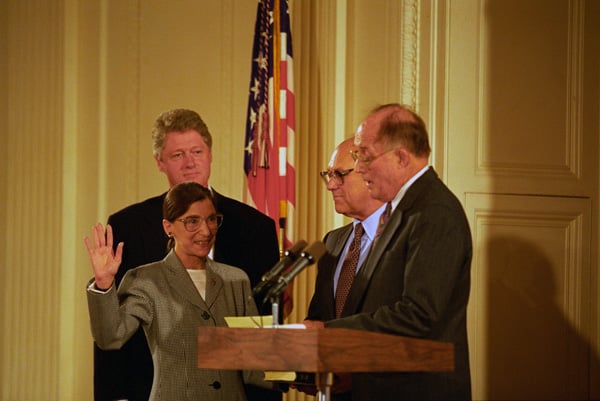
Chief Justice William Rehnquist swears-in Ginsburg as an Associate Justice of the Supreme Court as her husband Martin Ginsburg and President Clinton watch.
President Bill Clinton nominated her as an Associate Justice of the Supreme Court on June 14, 1993, to fill the seat vacated by retiring Justice Byron White. Ginsburg was recommended to Clinton by then-U.S. Attorney General Janet Reno[25] after a suggestion by Utah Republican Senator Orrin Hatch.[54] At the time of her nomination, Ginsburg was viewed as a moderate. Clinton was reportedly looking to increase the court's diversity, which Ginsburg did as the first Jewish justice since the 1969 resignation of Justice Abe Fortas. She was the second-ever female justice, and the first Jewish female justice.[52][55][56] She eventually became the longest-serving Jewish justice ever.[57] The American Bar Association's Standing Committee on the Federal Judiciary rated Ginsburg as "well qualified", its highest possible rating for a prospective justice.[58]
During her subsequent testimony before the United States Senate Committee on the Judiciary as part of the confirmation hearings, she refused to answer questions about her view on the constitutionality of some issues such as the death penalty as it was an issue that she might have to vote on if it came before the court.[59]
At the same time, Ginsburg did answer questions about some potentially controversial issues.
For instance, she affirmed her belief in a constitutional right to privacy and explained at some length her personal judicial philosophy and thoughts regarding gender equality.[60] Ginsburg was more forthright in discussing her views on topics about which she had previously written.[59] The United States Senate confirmed her by a 96 to 3 vote on August 3, 1993,[5][36] she received her commission on August 5, 1993,[36] and she took her judicial oath on August 10, 1993.[62]
Ginsburg's name was later invoked during the confirmation process of John Roberts. Ginsburg herself was not the first nominee to avoid answering certain specific questions before Congress,[6] and as a young lawyer in 1981 Roberts had advised against Supreme Court nominees' giving specific responses.[26] Nevertheless, some conservative commentators and Senators invoked the phrase "Ginsburg precedent" to defend his demurrers.[58][26] In a September 28, 2005, speech at Wake Forest University, Ginsburg said that Roberts' refusal to answer questions during his Senate confirmation hearings on some cases was "unquestionably right".[64]
Supreme Court jurisprudence
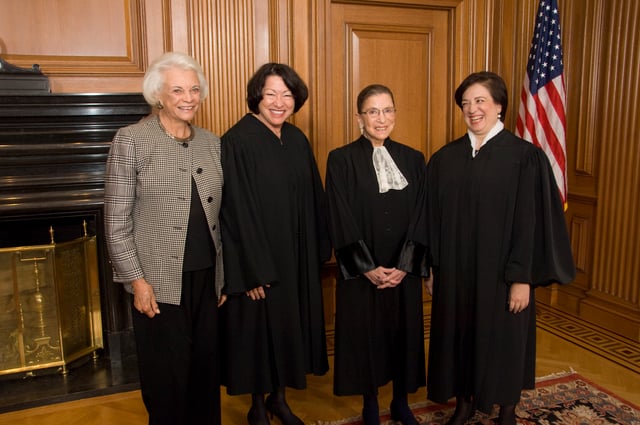
Sandra Day O'Connor, Sonia Sotomayor, Ginsburg, and Elena Kagan, October 1, 2010. O'Connor is not wearing a robe because she was retired from the court when the picture was taken.
Ginsburg characterizes her performance on the court as a cautious approach to adjudication.[4] She argued in a speech shortly before her nomination to the court that "[m]easured motions seem to me right, in the main, for constitutional as well as common law adjudication.
Doctrinal limbs too swiftly shaped, experience teaches, may prove unstable."[4] Legal scholar Cass Sunstein has characterized Ginsburg as a "rational minimalist", a jurist who seeks to build cautiously on precedent rather than pushing the Constitution towards her own vision.[67]
The retirement of Justice Sandra Day O'Connor in 2006 left Ginsburg as the only woman on the court.[68][7] Linda Greenhouse of The New York Times referred to the subsequent 2006–2007 term of the court as "the time when Justice Ruth Bader Ginsburg found her voice, and used it".[4] The term also marked the first time in Ginsburg's history with the court where she read multiple dissents from the bench, a tactic employed to signal more intense disagreement with the majority.[4]
With the retirement of Justice John Paul Stevens, Ginsburg became the senior member of what is sometimes referred to as the court's "liberal wing".[37][71][72] When the court splits 5–4 along ideological lines and the liberal justices are in the minority, Ginsburg often has the authority to assign authorship of the dissenting opinion because of her seniority.[71][8] Ginsburg has been a proponent of the liberal dissenters speaking "with one voice" and, where practicable, presenting a unified approach to which all of the dissenting justices can agree.[37][71]
Abortion
Ginsburg discussed her views on abortion and sexual equality in a 2009 New York Times interview, in which she said about abortion that "[t]he basic thing is that the government has no business making that choice for a woman".[74] Although Ginsburg has consistently supported abortion rights and joined in the court's opinion striking down Nebraska's partial-birth abortion law in Stenberg v. Carhart 530 U.S. 914 (2000), on the 40th anniversary of the court's ruling in Roe v. Wade 410 U.S. 113 (1973), she criticized the decision in Roe as terminating a nascent democratic movement to liberalize abortion laws which might have built a more durable consensus in support of abortion rights.[75] Ginsburg was in the minority for Gonzales v. Carhart, 550 U.S. 124 (2007), a 5–4 decision upholding restrictions on partial birth abortion. In her dissent, Ginsburg opposed the majority's decision to defer to legislative findings that the procedure was not safe for women. Ginsburg focused her ire on the way Congress reached its findings and with the veracity of the findings.[76] Joining the majority for Whole Woman's Health v. Hellerstedt, 579 U.S. 15-274 (2016), a case which struck down parts of a 2013 Texas law regulating abortion providers, Ginsburg also authored a short concurring opinion which was even more critical of the legislation at issue.[77] She asserted the legislation was not aimed at protecting women's health, as Texas had claimed, but rather to impede women's access to abortions.[76][77]
Gender discrimination
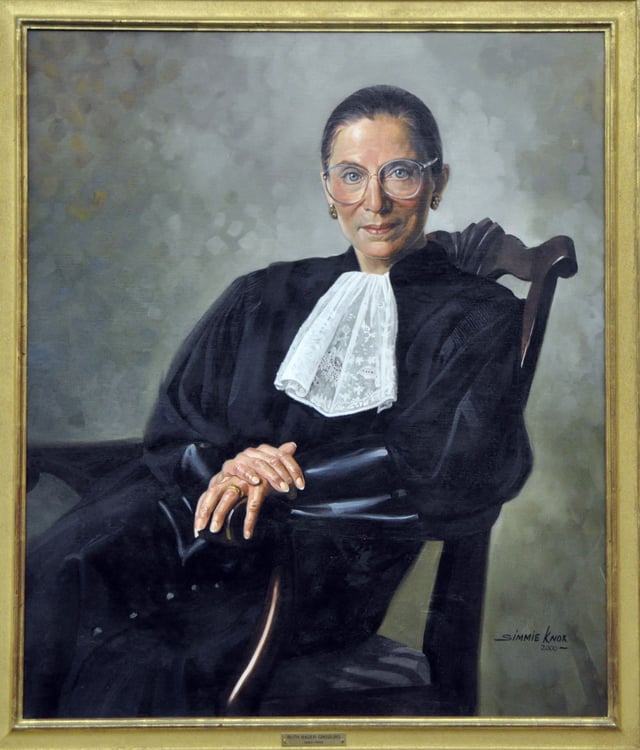
Commissioned portrait of Ginsburg in 2000
Ginsburg authored the court's opinion in United States v. Virginia, 518 U.S. 515 (1996), which struck down the Virginia Military Institute's (VMI) male-only admissions policy as violating the Equal Protection Clause of the Fourteenth Amendment. VMI is a prestigious, state-run, military-inspired institution that did not admit women. For Ginsburg, a state actor such as VMI could not use gender to deny women the opportunity to attend VMI with its unique educational methods.[78] Ginsburg emphasized that the government must show an "exceedingly persuasive justification" to use a classification based on sex.[79]
Ginsburg dissented in the court's decision on Ledbetter v. Goodyear, 550 U.S. 618 (2007), a case where plaintiff Lilly Ledbetter filed a lawsuit against her employer claiming pay discrimination based on her gender under Title VII of the Civil Rights Act of 1964. In a 5–4 decision, the majority interpreted the statute of limitations as starting to run at the time of every pay period, even if a woman did not know she was being paid less than her male colleague until later. Ginsburg found the result absurd, pointing out that women often do not know they are being paid less, and therefore it was unfair to expect them to act at the time of each paycheck. She also called attention to the reluctance women may have in male-dominated fields to making waves by filing lawsuits over small amounts, choosing instead to wait until the disparity accumulates.[50] As part of her dissent, Ginsburg called on Congress to amend Title VII to undo the court's decision with legislation.[81] Following the election of President Barack Obama in 2008, the Lilly Ledbetter Fair Pay Act, making it easier for employees to win pay discrimination claims, became law.[82][83] Ginsburg was credited with helping to inspire the law.[81][83]
Search and seizure
Although Ginsburg did not author the majority opinion, she was credited with influencing her colleagues on the case Safford Unified School District v. Redding, 557 U.S. 364 (2009).[4] The court ruled that a school went too far in ordering a 13-year-old female student to strip to her bra and underpants so that female officials could search for drugs.[4] In an interview published prior to the court's decision, Ginsburg shared her view that some of her colleagues did not fully appreciate the effect of a strip search on a 13-year-old girl. As she pointed out, "They have never been a 13-year-old girl."[85] In an 8–1 decision, the court agreed that the school's search went too far and violated the Fourth Amendment and allowed the student's lawsuit against the school to go forward. Only Ginsburg and Stevens would have allowed the student to sue individual school officials as well.[4]
In Herring v. United States, 555 U.S. 135 (2009), Ginsburg dissented from the court's decision not to suppress evidence due to a police officer's failure to update a computer system. In contrast to Roberts' emphasis on suppression as a means to deter police misconduct, Ginsburg took a more robust view on the use of suppression as a remedy for a violation of a defendant's Fourth Amendment rights. Ginsburg viewed suppression as a way to prevent the government from profiting from mistakes, and therefore as a remedy to preserve judicial integrity and respect civil rights.[86] She also rejected Roberts' assertion that suppression would not deter mistakes, contending making police pay a high price for mistakes would encourage them to take greater care.[86]
International law
Ginsburg has also advocated the use of foreign law and norms to shape U.S. law in judicial opinions; this was a view that was not shared by some of her conservative colleagues.
Ginsburg supports using foreign interpretations of law for persuasive value and possible wisdom, not as precedent which the court is bound to follow.[87] Ginsburg has expressed the view that consulting international law is a well-ingrained tradition in American law, counting John Henry Wigmore and President John Adams as internationalists.[88] Ginsburg's own reliance on international law dates back to her time as an attorney; in her first argument before the court, Reed v. Reed, 404 U.S. 71 (1971), she cited two German cases.[89] In her concurring opinion in Grutter v. Bollinger, 539 U.S. 306 (2003), a decision upholding Michigan Law School's affirmative action admissions policy, Ginsburg noted there was accord between the notion that affirmative action admissions policies would have an end point and agrees with international treaties designed to combat racial and gender based discrimination.[88]
Notable cases
United States v. Virginia, 518 U.S. 515 [184] (1996) Court Opinion
United States v. O'Hagan, 521 U.S. 642 [185] (1997) Court Opinion
Olmstead v. L.C., 527 U.S. 581 [186] (1999) Court Opinion
Friends of the Earth, Inc. v. Laidlaw Environmental Services, Inc., 528 U.S. 167 [187] (2000) Court Opinion
Bush v. Gore, 531 U.S. 98 [188] (2000) Dissenting
Eldred v. Ashcroft, 537 U.S. 186 (2003) Court Opinion
Exxon Mobil Corp. v. Saudi Basic Industries Corp., 544 U.S. 280 [189] (2005) Court Opinion
Ledbetter v. Goodyear Tire & Rubber Co., 550 U.S. 618 [190] (2007) Dissenting
Gonzales v. Carhart, 550 U.S. 124 [191] (2007) Dissenting
Ricci v. DeStefano, 557 U.S. 557 [192] (2009) Dissenting
National Federation of Independent Business v. Sebelius 567 U.S. 519 [193] (2012) Concurring in part, dissenting in part, from the Court's Opinion
Burwell v. Hobby Lobby Stores, Inc., 573 U.S. ___ [194] (2014) Dissenting
Other activities
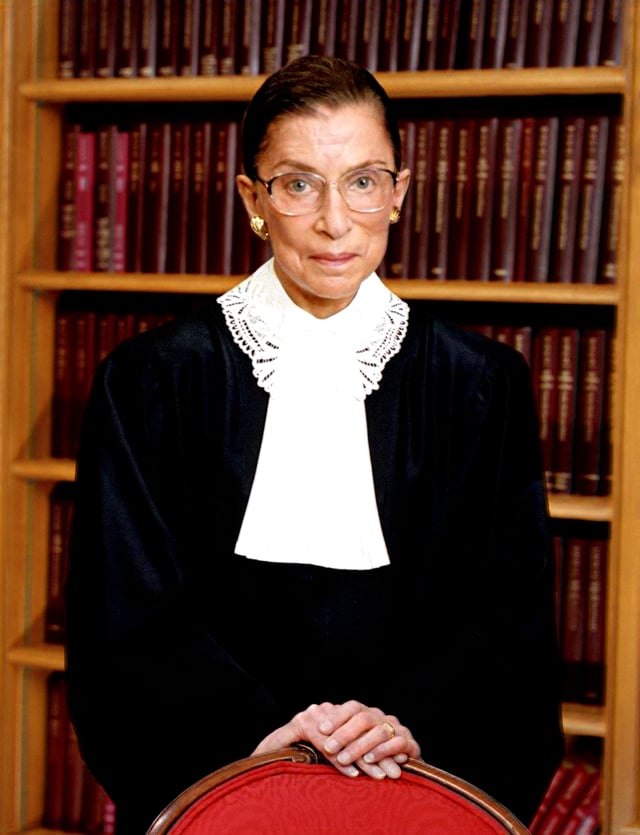
Portrait of Ginsburg, c. 2006

Ginsburg speaks at a naturalization ceremony at the National Archives in 2018
At his request, Ginsburg administered Vice President Al Gore's oath of office to a second term during the second inauguration of Bill Clinton on January 20, 1997.[90] She was the third woman to administer an inaugural oath of office.[91] Ginsburg is believed to be the first Supreme Court justice to officiate at a same-sex wedding, performing the August 31, 2013, ceremony of Kennedy Center President Michael Kaiser and John Roberts, a government economist.[92] Earlier that summer, the court had bolstered same-sex marriage rights in two separate cases.[93][94] Ginsburg believed the issue being settled led same-sex couples to ask her to officiate as there was no longer the fear of compromising rulings on the issue.[93]
The Supreme Court bar formerly inscribed its certificates "in the year of our Lord", which some Orthodox Jews opposed, and asked Ginsburg to object to.
She did so, and due to her objection, Supreme Court bar members have since been given other choices of how to inscribe the year on their certificates.[95]
Despite their ideological differences, Ginsburg considered Scalia her closest colleague on the court.
The two justices often dined and attended the opera together.[96] In her spare time, Ginsburg has appeared in several operas in non-speaking supernumerary roles such as Die Fledermaus (2003) and Ariadne auf Naxos (1994 with Scalia, and 2009), and spoke lines penned by herself in The Daughter of the Regiment (2016).[97]
In January 2012, Ginsburg went to Egypt for four days of discussions with judges, law school faculty, law school students, and legal experts.[98][99] In an interview with Al Hayat TV, she stated that the first requirement of a new constitution should be that it would "safeguard basic fundamental human rights like our First Amendment". Asked if Egypt should model its new constitution on those of other nations, she said Egypt should be "aided by all Constitution-writing that has gone on since the end of World War II", she cited the United States Constitution and Constitution of South Africa as documents she might look to if drafting a new constitution. She said the U.S. was fortunate to have a constitution authored by "very wise" men but pointed out that in the 1780s, no women were able to participate directly in the process, and slavery still existed in the U.S.[100]
During three separate interviews that were conducted in July 2016, Ginsburg criticized presumptive Republican presidential nominee Donald Trump, telling The New York Times and the Associated Press that she did not want to think about the possibility of a Trump presidency. She joked that she might consider moving to New Zealand.[101][102] She later apologized for commenting on the presumptive Republican nominee, calling her remarks "ill advised".[103]
Ginsburg's first book, My Own Words published by Simon & Schuster, was released October 4, 2016.[104] The book debuted on the New York Times Best Seller List for hardcover nonfiction at No. 12.[105] While promoting her book in October 2016 during an interview with Katie Couric, Ginsburg responded to a question about Colin Kaepernick choosing not to stand for the national anthem at sporting events calling the protest "really dumb". She later apologized for her criticism calling her earlier comments "inappropriately dismissive and harsh" and noting she had not been familiar with the incident and should have declined to respond to the question.[106][107][108]
In 2018, Ginsburg expressed her support for the #MeToo movement, which encourages women to speak up about their experiences with sexual harassment.[109] She told an audience, "It's about time. For so long women were silent, thinking there was nothing you could do about it, but now the law is on the side of women, or men, who encounter harassment and that's a good thing."[109] She also reflected on her own experiences with gender discrimination and sexual harassment, including a time when a chemistry professor at Cornell unsuccessfully attempted to trade her exam answers for sex.[109]
Personal life

Martin and Ruth Ginsburg at a White House event, 2009
A few days after Bader graduated from Cornell, she married Martin D. Ginsburg, who later became an internationally prominent tax lawyer.
Upon her accession to the D.C.
Circuit, the couple moved from New York to Washington, D.C., where her husband became professor of law at Georgetown University Law Center. Their daughter, Jane C. Ginsburg (b. 1955), is a professor at Columbia Law School. Their son, James Steven Ginsburg (b. 1965), is the founder and president of Cedille Records, a classical music recording company based in Chicago, Illinois. Ginsburg is a grandmother of four.[110]
After the birth of their daughter, her husband was diagnosed with testicular cancer. During this period, Ginsburg attended class and took notes for both of them, typed her husband's dictated papers and cared for their daughter and her sick husband—all while making the Harvard Law Review. They celebrated their 56th wedding anniversary on June 23, 2010. Martin Ginsburg died of complications from metastatic cancer on June 27, 2010.[111] They spoke publicly of being in a shared earning/shared parenting marriage including in a speech Martin Ginsburg wrote and had intended to give before his death that Ruth Bader Ginsburg delivered posthumously.[112]
Although Bader was raised in a Jewish home, she became non-observant when she was excluded from the minyan for mourners after the death of her mother. There was a "house full of women", but Bader, as a woman, was excluded. Orthodox Judaism requires that 10 Jewish men (over the age of 13) be present for a minyan, and women are excluded from being counted. She notes that her attitude might be different, following her attendance at a bat mitzvah ceremony in a more liberal stream of Judaism where the rabbi and cantor were both women.[113] In March 2015, Ginsburg and Rabbi Lauren Holtzblatt released "The Heroic and Visionary Women of Passover", an essay highlighting the roles of five key women in the saga: "These women had a vision leading out of the darkness shrouding their world. They were women of action, prepared to defy authority to make their vision a reality bathed in the light of the day."[114] In addition, she decorates her chambers with an artist's rendering of the Hebrew phrase from Deuteronomy, "Zedek, zedek, tirdof", ("Justice, justice shall you pursue") as a reminder of her heritage and professional responsibility.[115]
Following her appointment to the Supreme Court in 1993, Ginsburg deviated from court tradition by wearing a French robe d'avocat, as opposed to the traditional American judicial robe. The French robe differs from the American with its exposed buttons, open sleeves, standing collar, and white rabat. On the left shoulder of the robe are two buttons intended for the fastening of an epitoge, traditionally worn by French lawyers. In later years, Ginsburg would shift from the traditionally uniform white French rabat and begin wearing more varied and fanciful jabots, necklaces, and other forms of neckwear. Some time later, fellow female Supreme Court justice Sandra Day O'Connor would follow Ginsburg's lead and begin wearing the French robe d'avocat as well.
Ginsburg has a collection of lace jabots from around the world.[116][117] She stated in 2014 that she has a particular jabot that she wears when issuing her dissents (black with gold embroidery and faceted stones) as well as another she wears when issuing majority opinions (crocheted yellow and cream with crystals), which was a gift from her law clerks.[116][117] Her favorite jabot (woven with white beads) is from Cape Town, South Africa.[116]
Health
In 1999, Ginsburg was diagnosed with colon cancer; she underwent surgery that was followed by chemotherapy and radiation therapy. During the process, she did not miss a day on the bench.[118] Ginsburg was physically weakened by the cancer treatment, and she began working with a personal trainer. Since 1999, Bryant Johnson, a former Army reservist attached to the Special Forces, has trained Ginsburg twice weekly in the justices-only gym at the Supreme Court.[119][120] In spite of her small stature, Ginsburg saw her physical fitness improve since her first bout with cancer; she was able to complete 20 push-ups in a session before her 80th birthday.[119][83]
On February 5, 2009, she again underwent surgery, this time for pancreatic cancer.[122][50] Ginsburg had a tumor that was discovered at an early stage.[122] She was released from a New York City hospital on February 13 and returned to the bench when the Supreme Court went back into session on February 23, 2009.[124][125][126] On September 24, 2009, Ginsburg was hospitalized in Washington, DC, for lightheadedness following an outpatient treatment for iron deficiency and was released the following day.[127] On November 26, 2014, she had a stent placed in her right coronary artery after experiencing discomfort while exercising in the Supreme Court gym with her personal trainer.[128][129]
On November 8, 2018, she was hospitalized after fracturing three ribs in a fall in her office at the Supreme Court.[130] A day later, it was reported that Ginsburg had returned to official judicial work after a day of observation.[131][132] An outpouring of public support followed.[133][134] A CT scan of her ribs following her November 8 fall showed cancerous nodules in her lungs.[135] On December 21, Ginsburg underwent a left-lung lobectomy at Memorial Sloan Kettering Cancer Center to remove the nodules.[135] On January 7, 2019, for the first time since joining the Court more than 25 years earlier, Ginsburg missed oral argument while she recuperated.[136] She returned to the Supreme Court on February 15, 2019, to participate in a private conference with other justices in her first appearance at the court since her cancer surgery in December 2018.[4] On August 24, 2019, it was revealed that Ginsburg had recently completed three weeks of focused radiation treatment to ablate a tumor found in her pancreas over the summer.[138]
Future plans
When John Paul Stevens retired in 2010, Ginsburg became the oldest justice on the court at age 77.[139] Despite rumors that she would retire because of advancing age, poor health, and the death of her husband,[140][141] she denied she was planning to step down. In an August 2010 interview, Ginsburg stated that her work on the court was helping her cope with the death of her husband.[139] She also expressed a wish to emulate Justice Louis Brandeis' service of nearly 23 years, which she achieved in April 2016.[139][142] She stated she has a new "model" to emulate in former colleague Justice John Paul Stevens, who retired at age 90 after nearly 35 years on the bench.[142]
During the presidency of Barack Obama, some progressive lawyers and activists called for Ginsburg to retire so that Obama would be able to appoint a like-minded successor,[143][144][145] particularly while the Democratic Party held control of the U.S. Senate.[146] They pointed to Ginsburg's age and past health issues as factors making her longevity uncertain.[144] Ginsburg rejected these pleas.[71] She affirmed her wish to remain a justice as long as she was mentally sharp enough to perform her duties.[71] Moreover, Ginsburg opined that the political climate would prevent Obama from appointing a jurist like herself.[147]
Recognition
In 2002, Ginsburg was inducted into the National Women's Hall of Fame.[148] Ginsburg has been named one of 100 Most Powerful Women (2009),[149] one of Glamour*]]magazine's Women of the Year 2012,[150] and one of* Time agazine's 100 most influential people (2015).[151] She has been awarded honorary Doctor of Laws degrees by Willamette University (2009),[152] Princeton University (2010),[153] and Harvard University (2011).[154]
In 2013, a painting featuring the four female justices to have served as justices on the Supreme Court (Ginsburg, Sandra Day O'Connor, Sonia Sotomayor, and Elena Kagan) was unveiled at the Smithsonian's National Portrait Gallery in Washington, D.C.[155][156] According to the Smithsonian at the time, the painting was on loan to the museum for three years.[155]
Researchers at the Cleveland Museum of Natural History gave a species of praying mantis the name Ilomantis ginsburgae after Ginsburg. The name was given because the neck plate of the Ilomantis ginsburgae bears a resemblance to a jabot, which Ginsburg is known for wearing. Moreover, the new species was identified based upon the female insect's genitalia instead of based upon the male of the species. The researchers noted that the name was a nod to Ginsburg's fight for gender equality.[157][158]
In popular culture
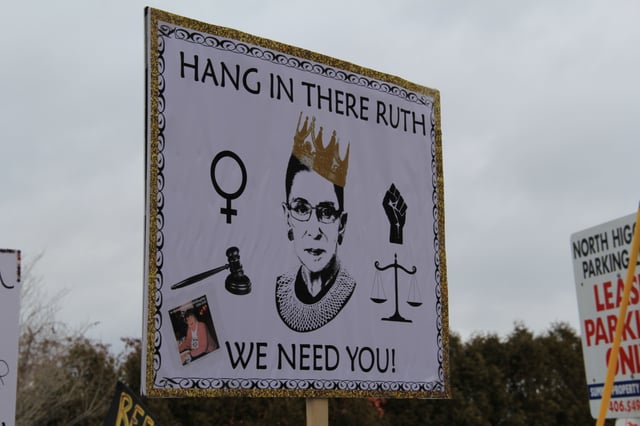
A poster depicting Ginsburg as "the Notorious R.B.G." in the likeness of American rapper The Notorious B.I.G., 2018
Ginsburg has been referred to as a "pop culture icon".[159][160][161] Ginsburg's profile began to rise after O'Connor's retirement in 2006 left Ginsburg as the only serving female justice. Her increasingly fiery dissents, particularly in Shelby County v. Holder 570 U.S. 2 (2013), led to the creation of the Notorious R.B.G. Tumblr and Internet meme comparing the justice to rapper The Notorious B.I.G.[162] The creator of the Notorious R.B.G. Tumblr, then-law student Shana Knizhnik, teamed up with MSNBC reporter Irin Carmon to turn the blog into a book titled Notorious RBG: The Life and Times of Ruth Bader Ginsburg.[4] Released in October 2015, the book became a New York Times bestseller.[164] In 2015, Ginsburg and Scalia, known for their shared love of opera, were fictionalized in Scalia/Ginsburg, an opera by Derrick Wang.[165]
Additionally, Ginsburg's pop culture appeal has inspired nail art, Halloween costumes, a bobblehead doll, tattoos, t-shirts, coffee mugs, and a children's coloring book among other things.[4][166][167][168] She appears in both a comic opera and a workout book.[168] Musician Jonathan Mann also made a song using part of her Burwell v. Hobby Lobby Stores, Inc. dissent.[169] Ginsburg has admitted to having a "large supply" of Notorious R.B.G. t-shirts, which she distributes as gifts.[170]
Since 2015, Ginsburg has been portrayed by Kate McKinnon on Saturday Night Live.[171] McKinnon has repeatedly reprised the role, including during a Weekend Update sketch that aired from the 2016 Republican National Convention in Cleveland.[172][173] The segments typically feature McKinnon-as-Ginsburg lobbing insults she calls "Ginsburns" and doing a celebratory dance.[174][175] Filmmakers Betsy West and Julie Cohen created a documentary about Ginsburg, titled RBG, for CNN Films, which premiered at the 2018 Sundance Film Festival.[176][31] In the film Deadpool 2 (2018), a photo of her is shown as Deadpool considers her for his X-Force, a team of superheroes.[177] Another film, On the Basis of Sex, focusing on Ginsburg's career struggles fighting for equal rights, was released later in 2018; its screenplay was named to the Black List of best unproduced screenplays of 2014.[178] English actress Felicity Jones portrays Ginsburg in the film, with Armie Hammer as her husband Marty.[179] Ginsburg herself has a cameo in the film.[180] The seventh season of the sitcom New Girl features a three-year-old character named Ruth Bader Schmidt, named after Ginsburg.[181] A Lego mini-figurine of Ginsburg is shown within a brief segment of The Lego Movie 2. Ginsburg gave her blessing for the cameo, as well as to have the mini-figurine produced as part of the Lego toy sets following the film's release in February 2019.[182] Also in 2019, Samuel Adams released a limited-edition beer called When There Are Nine, referring to Ginsburg's well-known reply to the question about when there would be enough women on the Supreme Court.[183]
See also
Bill Clinton U.S. Supreme Court candidates
Demographics of the U.S. Supreme Court
List of Justices of the U.S. Supreme Court
List of law clerks of the U.S. Supreme Court
List of U.S. Supreme Court cases during the Rehnquist Court
List of U.S. Supreme Court cases during the Roberts Court
List of U.S. Supreme Court Justices by time in office
List of Jewish United States Supreme Court justices